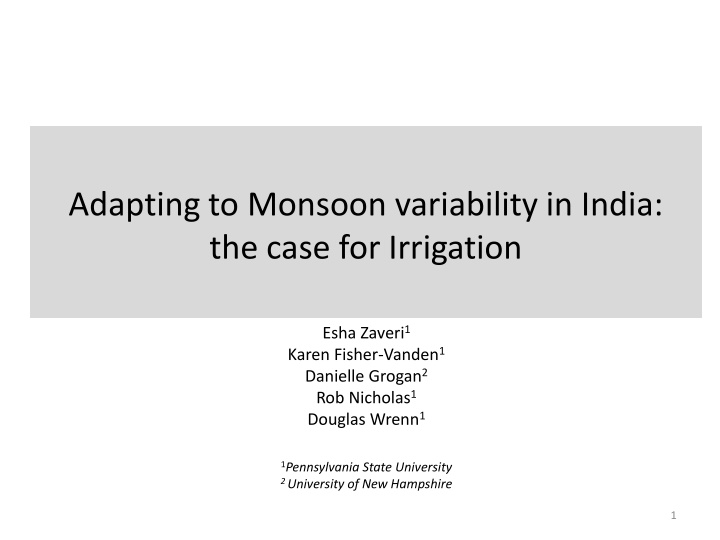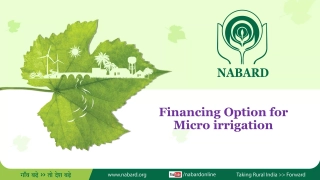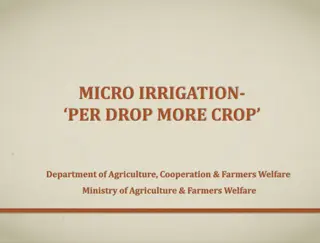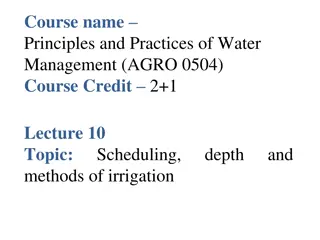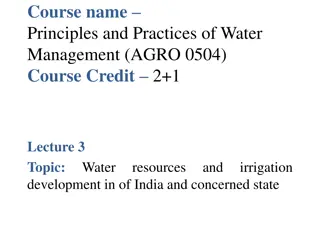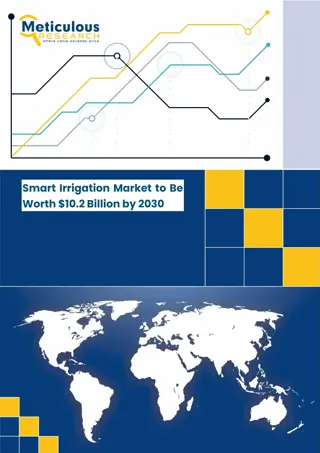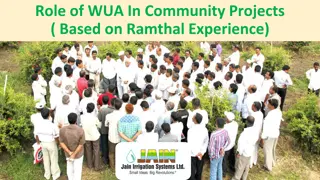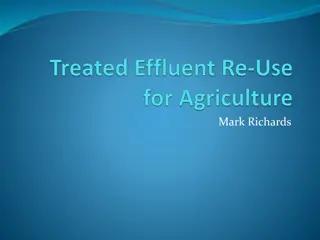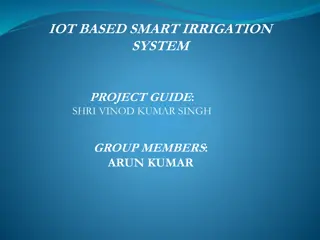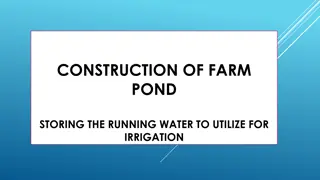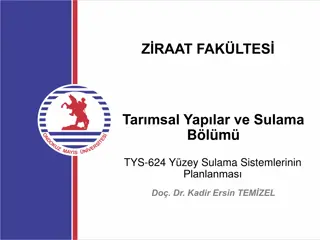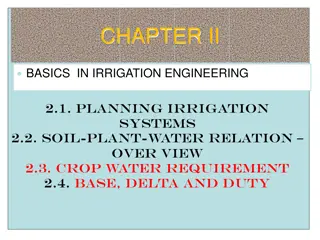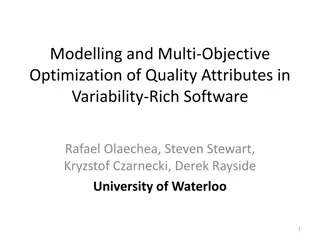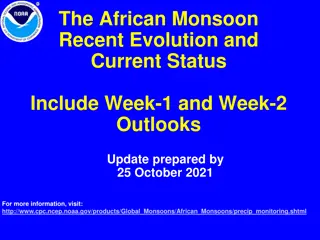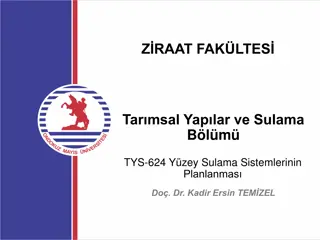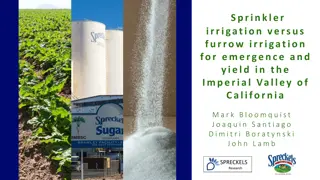Adapting to Monsoon Variability in India: The Case for Irrigation
This study explores the impact of monsoon variability on crop irrigation in India using an empirical model. It examines changes in crop irrigated areas in response to monsoon variations, focusing on rice, wheat, and sorghum. The research analyzes crop water needs, sensitivity to drought, and irrigation ratios over the historical period of 1970-2004, considering factors like lag of irrigation ratio, rainfall patterns, and planting seasons. The study emphasizes the importance of adapting irrigation strategies to mitigate the effects of monsoon variability on agriculture in India.
Download Presentation

Please find below an Image/Link to download the presentation.
The content on the website is provided AS IS for your information and personal use only. It may not be sold, licensed, or shared on other websites without obtaining consent from the author.If you encounter any issues during the download, it is possible that the publisher has removed the file from their server.
You are allowed to download the files provided on this website for personal or commercial use, subject to the condition that they are used lawfully. All files are the property of their respective owners.
The content on the website is provided AS IS for your information and personal use only. It may not be sold, licensed, or shared on other websites without obtaining consent from the author.
E N D
Presentation Transcript
Adapting to Monsoon variability in India: the case for Irrigation Esha Zaveri1 Karen Fisher-Vanden1 Danielle Grogan2 Rob Nicholas1 Douglas Wrenn1 1Pennsylvania State University 2 University of New Hampshire 1
Empirical Model Connection to WBM Connection to IAM Background 2
Empirical Model Connection to WBM Connection to IAM Empirical Model Step 1: How have crop irrigated areas changed in response to monsoon variability in India? Percentage change in Monsoon rainfall from 1970 to 2004 Season Crop water need (mm/total growing period) Sensitivity to drought Rice Kharif, Rabi 450-700 high Wheat Rabi 450-650 low-medium 3 Source: Brouwer and Heibloem(FAO,1986) Sorghum Kharif, Rabi 450-650 low Source: Brouwer and Heibloem(FAO,1986)
Empirical Model Connection to WBM Connection to IAM Empirical Model Step 1: How have crop irrigated areas changed in response to monsoon variability in India? Season Crop water need (mm/total growing period) Sensitivity to drought Rice Kharif, Rabi 450-700 high Wheat Rabi 450-650 low-medium 4 Source: Brouwer and Heibloem(FAO,1986) Sorghum Kharif, Rabi 450-650 low Source: Brouwer and Heibloem(FAO,1986)
Empirical Model Connection to WBM Connection to IAM Empirical model Dependent variable: Irrigation ratio ???= ? ??,? ?,, ??? ?,?????,???????? ,i = 0,1,2,.. Wheat (1) (2) (3) (4) ???= ?00+ ????,? ?+ ????,? ?+ ?2?????+ ??+ ??+ ??? + ??? Lag of irrigation ratio 0.362** (0.123) 0.310*** (0.059) 0.363** (0.123) 0.310*** (0.059) 0.334* (0.130) 0.308*** (0.087) 0.045 (0.080) -0.074 (0.071) -0.075 (0.057) -0.061* (0.027) 0.044* (0.019) -0.140* (0.061) -0.692 (0.588) 0.412 (5.405) 6659 0.508 ???= ??.?? ???? ????,????? ????????????? 2 year lag of irrigation ratio 3 year lag of irrigation ratio Historical period: 1970-2004 1970 no. of rain days -0.149 (0.092) -0.061 (0.066) -0.054 (0.064) -0.063 (0.047) -0.054* (0.024) 0.047** (0.018) -0.126+ (0.066) -0.363* (0.175) -3.517 (2.837) 6932 0.517 2004 Lag of no. of rain days Monsoon rain -0.044 (0.034) -0.053* (0.024) 1 year: Lag of monsoon rain May June Sep Oct Dec Feb June 70 70 70 70 71 71 Rabi degree days -0.201*** (0.047) -0.246 (0.272) -22.367*** (1.775) 7500 0.272 -0.130* (0.063) -0.358* (0.174) -3.378 (2.762) 6932 0.517 Kharif Rabi planting planting Kharif degree days Constant 80% monsoon N R-sq (within) Major Rabi crop: Wheat , mostly grown in the Rabi season across states. * p<0.05 ** p <0.01 ***p < 0.001. All variables are in logarithmic form. Coefficients are elasticities. Standard errors clustered at district level. 5 16 states. 311 districts
Empirical Model Connection to WBM Connection to IAM Empirical model Dependent variable: irrigation ratio ???= ? ??,? ?,, ??? ?,?????,???????? ,i = 0,1,2,.. Kharif sorghum (1) (3) (6) (7) ???= ?00+ ????,? ?+ ????,? ?+ ?2?????+ ??+ ??+ ??? + ??? Lag of irrigation ratio 0.310*** 0.312*** 0.313*** ???= ??.?? ???? ????,????? ????????????? (0.025) (0.025) (0.026) 2 year lag of irrigation ratio 0.113*** 0.112*** 0.086*** (0.022) (0.022) (0.023) 3 year lag of irrigation ratio 0.051* Historical period: 1970-2004 1970 (0.025) 2004 no. of rain days -0.931+ -1.599** -1.619** -1.747*** (0.546) (0.500) (0.494) (0.511) Lag of no. of rain days 0.436 0.276 (0.420) (0.417) 1 year: Monsoon rain -0.948*** -0.808*** -0.802*** -0.863*** (0.169) (0.155) (0.155) (0.157) May June Sep Oct Dec Feb June 70 70 70 70 71 71 Lag of monsoon rain -0.013 -0.066 (0.144) (0.144) Kharif degree days 1.525** 0.157 0.158 -0.622 Kharif Rabi planting planting (0.467) (0.820) (0.824) (2.654) Constant -20.627* -5.505 -7.051 3.726 (9.097) (7.775) (7.993) (21.106) 80% monsoon N 5736 5353 5353 5162 R-sq (within) 0.149 0.271 0.271 0.273 Major Kharif crop: Kharif Sorghum grown only in the Kharif season * p<0.05 ** p <0.01 ***p < 0.001. All variables are in logarithmic form. Coefficients are elasticities. Standard errors clustered at district level. 16 states. 311 districts 6
Empirical Model Connection to WBM Connection to IAM Connection to the Water Balance Model Step 1: Looking back: How have irrigated areas changed in response to monsoon variability in India? Step 2: Looking forward: How will future changes in precipitation affect water supply? -Use projections of precipitation changes to estimate irrigation responses into the future using estimates from Step 1 7
Empirical Model Connection to WBM Connection to IAM Connection to the IAM Step 1: Looking back: How have irrigated areas changed in response to monsoon variability in India? Step 2: Looking forward: How will future changes in precipitation affect water supply? -Use projections of precipitation changes to estimate irrigation responses into the future using estimates from Step 1 Step 3 : What are the future economic impacts? -Use empirical estimates from Step 1 to inform demand for water in IAM agricultural sector in response to changes in precipitation -Use WBM to inform supply side of water resources (fixed factor) in IAM - Capture changes in crop production and crop trade balance via virtual water trade 8
Empirical Model Connection to WBM Connection to IAM Further extensions Further extensions 1. Use NSS 59th Round (plot level data) to analyze irrigation decisions Ag Year: July 2002-June 2003 2002 2003-time of survey July Aug Dec Jan Feb June Aug Sep Dec Kharif harvest Rabi harvest 1st Visit 2nd Visit (Kharif season holdings ) (Rabi season holdings) 10
Empirical Model Connection to WBM Connection to IAM Further extensions Further extensions 2. Use hydro-geological maps, and type of irrigation to further disaggregate irrigation change 11 Source: CGWB
